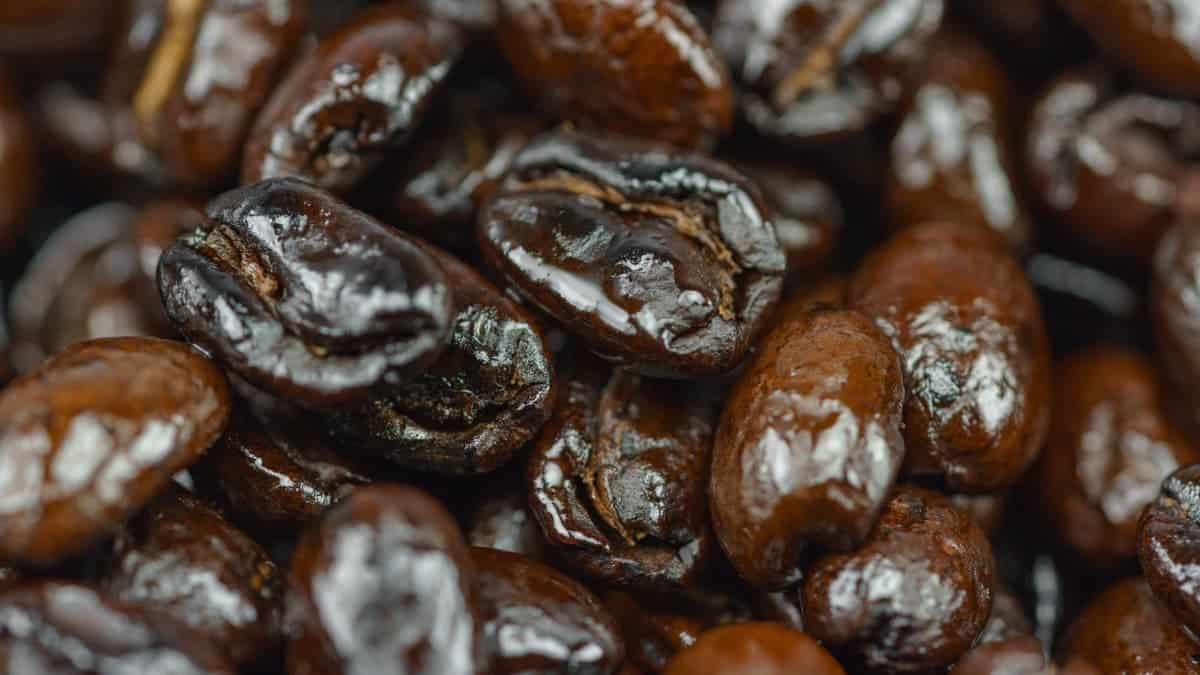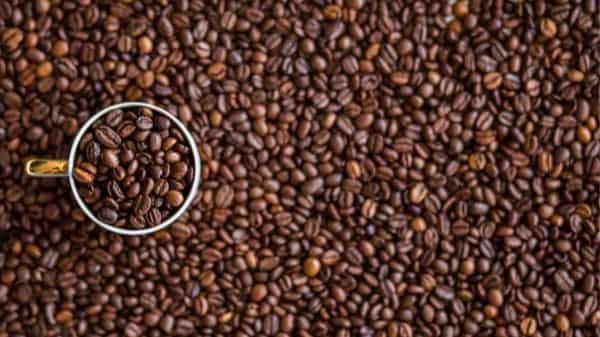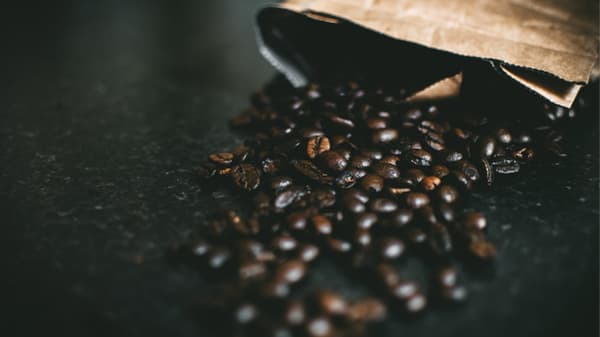Are Oily Coffee Beans Any Good?
As an ex-barista, I’m only looking for the freshest beans to grind and brew.
If, like me, you’re on a quest for the perfect cup, perhaps you’ve noticed that some roasts are strangely shiny.
But are oily coffee beans any good?
Well, it depends. An oily sheen can reflect the coffee’s freshness, but it’s complicated… so keep reading to learn what causes this oiliness and how to use outdated roasts.

Why Are Coffee Beans Oily?
All coffee beans naturally contain oils. Roasting the beans releases these oils along with organic acids. The longer the roasting process, the oilier and less acidic the bean.
Put simply: dark roast coffee beans should be oily. When fresh, a medium or light roast will contain a more acidic, oil-free coffee bean.
Given enough time, these coffee oils will permeate the surface of the bean. Even if they weren’t roasted to the second crack indicative of darker roasting.
So if you have light or medium roast coffee beans that are oily, this indicates staleness.
In the next section, I’ll summarize the stages of the coffee roasting process.
That way, we can understand how these oils escape and why that’s not necessarily a bad thing.
Coffee Roasting 101
Coffee beans are the seeds found within coffee cherries. When harvested, these “seeds” are a
light, olive green. They sort of resemble a cross between a peanut and pistachio.
The seeds are technically edible in this form… But they’re very acidic, grassy, and difficult to chew. So we roast them to develop the flavor compounds housed within the beans.
Roasting coffee beans causes them to “crack”. This opening allows the oils to escape, permeating the surface of the bean. So again, the darker (aka longer) the roast the oiler the bean.
A coffee’s roasting profile results from the amount of temperature and time applied to the beans. The type of roast will affect the flavor, body, aroma, and caffeine content of your cup of coffee.
Let’s jump into the details.

Stages
The exact number of stages in the coffee roasting process depends on how roasted you want your coffee. But for a palatable coffee, even a light roast will go through the first four stages.
- Stage 1: Yellow Point – the green beans dry out over a few minutes at a lower temperature.
- Stage 2: Browning Stage – the Maillard Reaction begins, producing rich aromas; beans begin to darken.
- Stage 3: The Caramelization Process – increasing temperatures develop important flavour compounds; heating sugars caramelize inside the beans.
- Stage 4: First Crack – water inside the beans vaporizes, making the beans break. (If you’re trying to achieve a lighter roast, stop here. Roasting beyond the first crack takes your beans into medium roast territory.)
- Stage 5: Roast Development – caramelization continues, affecting acidity, body, and flavor; the finer art of roasting happens in this delicate two-minute period.
- Stage 6: Second Crack – the coffee bean has now broken open twice; roast flavors eclipse the bean’s natural flavors.
- Dark Roast – best case scenario, roasting beyond the second crack gives you intense, smokey French or Italian Roasts; worst case scenario, the coffee sugars burn up entirely. Typically, the darker the coffee bean, the more oil you’ll find on its surface.
Coffee is very much an art of cooking chemistry. And the stages can be confusing. If you need a few more details, check out this in-depth guide to roasting stages.
(Pro tip: if you’re learning how to roast your own coffee, be prepared to batch a lot of cold brew. It’s the most forgiving brew method for less-than-ideal roasts.)
Related Read: Light VS Dark Roasts
Roast Temperature
Roasting is a balance of temperature and time. Typically, professional coffee roasters start with a temperature around 320° F, gradually increasing to 370 to 540° F.
High temperatures can cause the beans to roast too quickly. A fast roast increases the likelihood of scorching the beans, yes.
But more importantly, if beans don’t spend enough time in the Maillard reaction the coffee’s flavors and aromas won’t develop properly.
But the flavors in the beans also won’t develop if the roasting temperature is too low.
It’s a fine balance. On one end is the risk of a flat, unpleasantly flavored coffee. On the other end is coffee that tastes like ash because your beans have caught fire.
Temperature control is critical during the roast development stage.
Roast Time
Roast time greatly impacts flavor. This is especially true during the roast development stage. A shorter roasting time will give you higher acidity, fruity flavors, and a thinner body. For full-bodied chocolatey flavors with lower acidity, roast a bit longer.
Some coffee snobs turn up their noses at dark roasts. That’s because after the second crack, the roast flavors (i.e. smokiness) start to overwhelm the beans’ original flavors. But dark roasts can transform dull beans into a truly indulgent coffee.
Drinking coffee is all about personal enjoyment. So not every bean needs to be ready for a light roast. Sometimes you want that rich smokey goodness you can only get from oily coffee brewed in a French press.
And when you do have some high-quality coffee beans, reduce roast time to just after the first crack. Lighter roasts will showcase their delicate, complex flavors.
What Is The Problem With Oily Coffee Beans?
Oily coffee beans aren’t necessarily indicative of sub-optimal flavor or freshness. That being said, the oiliness does create a few practical issues.
If you’re worried about oily coffee beans, chances are you’re grinding your own beans. (You won’t be able to notice oily residue on coffee grounds, only whole beans.)
And unfortunately, when it comes to oily coffee beans, grinding is the point of friction — literally and metaphorically.
The oils make the grounds stick together. This stickiness can negatively affect extraction. But we’re not there yet.
At this stage, the stickiness creates hard, compact substances that can clog your grinder. Burr grinders are especially susceptible to this clogging.
Obviously, you don’t want to break your coffee machine. But you also don’t want poorly ground coffee.
The stickiness of oily beans makes it more difficult for your grinder to produce uniform, even grinds. So a perfect grind will be harder to achieve with a dark roast than with a medium to light roast coffee.
The oily residue can also make the bean hopper sticky. This becomes an issue when it prevents beans from flowing smoothly into the grinder. Fortunately, you can mitigate this risk with proper cleaning and maintenance.
(This cleaning might be more demanding on espresso machines with grinders, but it’s absolutely worth the effort.)
Those are the practical issues. What about the flavor and freshness of oily beans?
All coffee beans become oily over time. Darker roasts should be oily. But if you have an oily bag of light roasted coffee or medium roast coffee, the oily glean indicates staleness.

Making Coffee With Dark Oily Beans
Dark roast coffee has a bad reputation. If you listen to the critics, roasting beans beyond the second crack is just a way to cover up cheap, low-quality beans.
And, hey, maybe this is true in some cases. But regardless of the roaster’s intentions, dark roast beans can still produce delightful brewed coffee.
Especially if you adjust a few variables to prepare the oily beans correctly.
Grind Coarser
The best dark roasts offer intense chocolate flavors and a velvety, full body. But one of the dangers of dark roasting beans is creating a bitter cup of coffee.
Use a coarser grind to help extract the best the oily beans have to offer. Regardless of your brewing method, go slightly coarser to avoid bitterness.
Lower the Heat
The recommended water temperature for brewing coffee tends to be around 205° F. But for dark, oily beans, drop the temperature to as low as 195° F.
Lowering the water temperature reduces the risk of extracting bitter flavor compounds.
Alternatively, you could ditch hot coffee altogether and turn those oily roasts into cold brew. As the name suggests, cold brew uses cold water to steep the grounds. So you don’t have to worry about compromising brew technique.
Adjust Brew Method
Paper filters can trap the flavorful oils of dark roasts. So try an immersion brew method to make the most of oily beans.
For maximum enjoyment, brew dark French roasts in a French press. The clue is in the name.
And again, cold brew is a great way to repurpose coffee beans that have gone oily with age.
Wrapping Up: Oily Coffee Beans
The roasting process naturally releases coffee oils from the beans. The darker the roast, the oiler the bean.
An oily sheen can’t reflect the freshness of coffee beans so much as the staleness. Light and medium roast coffee beans will only develop an oily surface over time. So if your bag of blonde coffee beans has developed a shine, they’ve probably gone stale.
But dark roast coffee beans will be oily fresh out of the roaster.
To make the most of your fabulously oily French, Vienna, or Italian roast, use a French press.
And if you have older coffee beans, ignore the roast date. Turn those precious light or medium roast coffee beans into cold brew.
Once you’re finished, clean your grinder and bean hopper to avoid residual build up.

